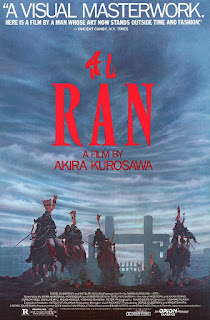Sunday, January 10, 2016
RAN
(December 1985, U.S.)
Happy New Year, people!
Perhaps some of you have noticed that it's been a couple of weeks since I've posted anything. I'll be completely honest with you...I needed a little time to motivate myself to sit down and watch Akira Kurosawa's RAN. Don't get me wrong - it's a great film, but it requires time, patience and concentration to really take it all in and fully appreciate it's cinematic worth and value. Lately, I seem to have devoted my moviegoing time to lighter fare, which has included the new STAR WARS movie (twice!), a full day of the Honeymooners marathon on New Year's Day, watching Disney's INSIDE OUT twice (and loving it!) and finally, some classic DVD episodes of STAR TREK and ALL IN THE FAMILY. You see, sometimes my brain just a needs a little break from the highly intelligent aspects of film...but hey, at least I'm not sinking so low as to watch reality TV!
RAN, a partial re-telling of Shakespeare's tragedy KING LEAR, was Kurosawa's last epic film and one of very powerful images and use of color, as it tells the story of the powerful Japanese warlord Hidetora Ichimonji (played by Tatsuya Nakadai), who at a time of showing significant age, decides to consolidate and divide his great kingdom among his three sons. As it would likely be predicted, this sort of paternal generosity breeds ambition, corruption and greed among the three brothers to the point where each of them, in turn, have betrayed their own father. Meanwhile, the wife of the oldest son (Taro) is secretly plotting her own revenge against Hidetora for massacring her family following her marriage to Taro. By her own diabolical scheming, she's managed to corrupt her husband into further acts of deception and betrayal (definitely some classic Shakespeare elements taking place here!). Inevitably, war and bloody battle take place and this is where Kurosawa's genius behind the camera becomes most prominent. Truth be told, as brilliant a film maker as Kurosawa was, I never held very much stock is his stories and plot lines (RASHOMON the exception). To truly experience Kurosawa is to allow one's self to dive into the visual journey of his films. Case in point for RAN, there is a lengthy battle sequence in which there's no dialogue, screaming or otherwise sounds of action and violence. The sequence is accompanied only by some soft, rather ethereal music that gives the viewer the impression of being lost in a surrealistic dream state. The battle is still violent and bloody (actually, the blood in these sequences looks rather fake, like the obvious color of red paint. Perhaps it's intentional, I'm not sure), and yet there's something almost unmistakably beautiful about all of it. Equally beautiful are scenes and moments of serenity filmed in large fields of wilderness where many of the film's characters are given the chance to contemplate the meaning of their lives, their purposes in this world and even the fear of their own death. When we walk away from RAN, we're likely to take with us just the images of great beauty and violence and how they're projected before our senses. And yet, despite whatever weaknesses their may be in the story or that it's merely just an adaptation of a previous great work, we can't avoid the contemplation and meaning behind a very corrupt family in which a good and righteous man is faced with the reality of having three very bad sons.
If you've seen enough of Kurosawa's films, you'll perhaps recognize certain repetitive features; not only in the film making style itself, but also in the conventional acting techniques of the cast. Perhaps the central theme of RAN is simply pure chaos. As a film making technique, many sequences of chaos and terror are often preceded by shots of thick, cumulonimbus clouds making their way toward the village, which inevitably break into the raging storm of battle. Throughout the chaos, many of the characters find themselves searching for signs of peace through God or Buddha, which ultimately never reveal themselves, even by the film's end. As is typical Shakespeare, nearly everyone in the film is dead at the end and we're left with little hope or signs of an optimistic future.
Although most of my experience with Kurosawa has been with his black and white films, RAN remains, nonetheless, a glorious achievement in cinematography, storytelling (well, adapted storytelling) and use of color. It's one of the best foreign subtitled films of the 1980s, in my opinion, and one I wish I'd seen on the big screen. Actually, I had my opportunity to see this film on screen when it was first released and played at the local movie theater across the street from my dorm building in Buffalo, New York. Unfortunately, I was still young and cinematically immature and my idea of a great movie was still the latest bullshit sequel or mindless comedy. Thank goodness, I grew up (well...eventually...sort of.). I can thank my employer from twenty years ago (thanks, Steve!) for turning me onto RAN when it would play (almost) continuously on the Bravo channel, when they still referred to themselves as "the film and arts network", unlike the pathetic "real housewives" network that they are today!
Favorite line or dialogue:
Hidetora Ichimonji: "What madness have I spoken? Wherein lies my senility?"
Saburo Ichimonji: "I'll tell you! What kind of world do we live in? One barren of loyalty and feeling!"
Hidetora: "I'm aware of that."
Saburo: "So you should be! You spilled an ocean of blood! You showed no mercy, no pity. We too are children of this age...weaned on strife and chaos! We are your sons, yet you count on our fidelity! In my eyes, that makes you a fool! A senile old fool!"
Subscribe to:
Post Comments (Atom)



No comments:
Post a Comment